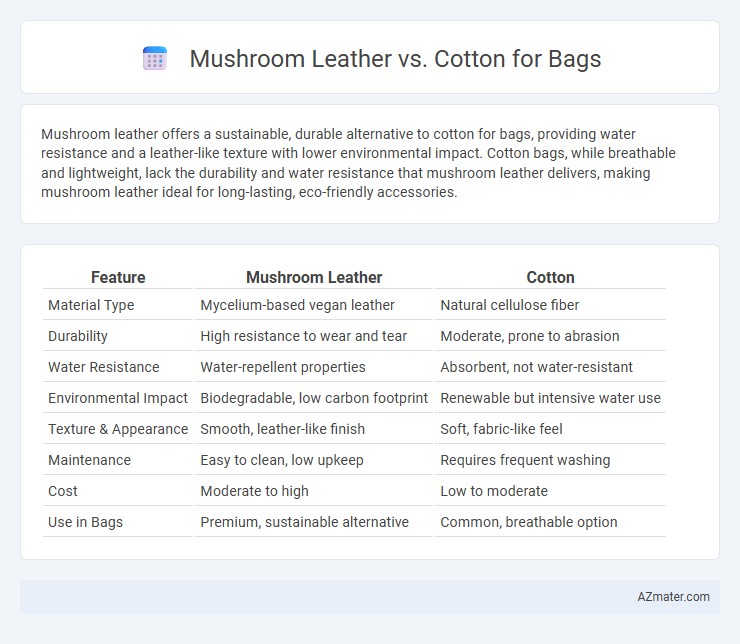Mushroom leather offers a sustainable, durable alternative to cotton for bags, providing water resistance and a leather-like texture with lower environmental impact. Cotton bags, while breathable and lightweight, lack the durability and water resistance that mushroom leather delivers, making mushroom leather ideal for long-lasting, eco-friendly accessories.
Table of Comparison
| Feature | Mushroom Leather | Cotton |
|---|---|---|
| Material Type | Mycelium-based vegan leather | Natural cellulose fiber |
| Durability | High resistance to wear and tear | Moderate, prone to abrasion |
| Water Resistance | Water-repellent properties | Absorbent, not water-resistant |
| Environmental Impact | Biodegradable, low carbon footprint | Renewable but intensive water use |
| Texture & Appearance | Smooth, leather-like finish | Soft, fabric-like feel |
| Maintenance | Easy to clean, low upkeep | Requires frequent washing |
| Cost | Moderate to high | Low to moderate |
| Use in Bags | Premium, sustainable alternative | Common, breathable option |
Introduction to Sustainable Bag Materials
Mushroom leather, derived from mycelium, offers a biodegradable and eco-friendly alternative to traditional cotton used in bag production. Unlike cotton, which requires extensive water and pesticide use, mushroom leather utilizes agricultural waste and grows rapidly with minimal resources. This innovation in sustainable bag materials reduces environmental impact while maintaining durability and aesthetic appeal.
What is Mushroom Leather?
Mushroom leather, also known as mycelium leather, is a sustainable alternative made from the root structure of mushrooms, offering eco-friendly production with minimal environmental impact. This material boasts a soft, flexible texture similar to animal leather but is biodegradable and requires fewer resources than cotton cultivation, which involves significant water and pesticide use. As a result, mushroom leather presents an innovative choice for bags, combining durability with sustainable practices that surpass traditional cotton in environmental benefits.
What is Cotton Fabric?
Cotton fabric is a natural textile derived from the fibers of the cotton plant, known for its breathability, softness, and durability in bag manufacturing. Unlike mushroom leather, which is an innovative, sustainable alternative made from fungal mycelium, cotton offers a traditional, biodegradable option widely used in eco-friendly bags. Cotton's moisture absorbency and lightweight properties make it a popular choice for casual and everyday carry bags, contrasting with the water-resistant and vegan characteristics of mushroom leather.
Environmental Impact: Mushroom Leather vs Cotton
Mushroom leather, made from mycelium, is a sustainable alternative to cotton as it requires significantly less water and land resources, reducing the overall environmental footprint. Cotton cultivation typically involves high water consumption and pesticide use, contributing to soil degradation and water pollution. Mushroom leather's biodegradability and low carbon emissions during production make it a more eco-friendly choice for bags compared to conventional cotton.
Durability and Strength Comparison
Mushroom leather offers superior durability compared to cotton, boasting water resistance and resistance to wear, which extends the lifespan of bags significantly. Cotton, while breathable and lightweight, tends to degrade faster under stress and exposure to moisture. The tensile strength of mushroom leather surpasses that of cotton, making it a more robust choice for long-lasting and sturdy bags.
Aesthetic Appeal and Design Versatility
Mushroom leather offers a unique, natural texture and rich earthy tones that enhance a bag's aesthetic appeal, making each piece visually distinctive and eco-conscious. Its pliable surface supports innovative designs and detailed craftsmanship, providing greater versatility compared to traditional cotton, which has a more uniform and flat appearance. Cotton bags, while lightweight and breathable, often lack the structural depth and luxury feel that mushroom leather delivers, positioning the latter as a superior choice for high-end, fashion-forward accessories.
Comfort and Usability Factors
Mushroom leather offers superior breathability and softness compared to traditional cotton, enhancing comfort during extended use. Its natural flexibility and water resistance improve durability and usability, making it ideal for bags exposed to varying environmental conditions. Cotton bags, while lightweight and easy to clean, lack the structural integrity and moisture-wicking properties characteristic of mushroom leather, often resulting in reduced long-term comfort and functionality.
Cost and Production Considerations
Mushroom leather offers a sustainable alternative to traditional cotton, with production costs typically higher due to its innovative fungal cultivation and processing methods. Cotton bags benefit from established large-scale farming and manufacturing infrastructure, resulting in lower material and production expenses. However, mushroom leather's eco-friendly attributes may justify its premium price, appealing to environmentally conscious consumers despite higher initial costs.
Market Trends and Consumer Preferences
Mushroom leather is gaining traction in the sustainable fashion market due to its eco-friendly production process and durability, appealing to environmentally conscious consumers. Cotton, while widely used for its softness and breathability, faces scrutiny for its water-intensive cultivation, prompting a shift toward alternative materials like mushroom leather. Market trends indicate rising demand for innovative, cruelty-free materials, with mushroom leather quickly becoming a preferred choice for premium, sustainable bags.
Which is Better for Bags: Mushroom Leather or Cotton?
Mushroom leather offers superior durability and water resistance compared to cotton, making it a more practical choice for bags exposed to daily wear and environmental elements. Cotton bags are breathable and lightweight but lack the strength and longevity of mushroom leather, which is also biodegradable and eco-friendly. Considering factors like sustainability, durability, and maintenance, mushroom leather is generally the better material for high-quality, long-lasting bags.

Infographic: Mushroom leather vs Cotton for Bag
 azmater.com
azmater.com